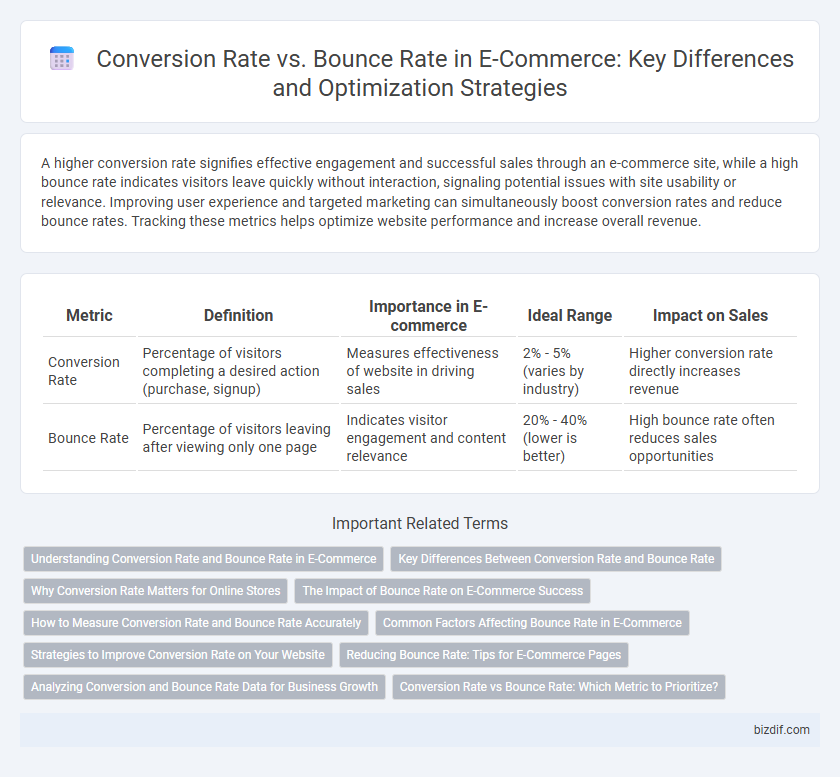A higher conversion rate signifies effective engagement and successful sales through an e-commerce site, while a high bounce rate indicates visitors leave quickly without interaction, signaling potential issues with site usability or relevance. Improving user experience and targeted marketing can simultaneously boost conversion rates and reduce bounce rates. Tracking these metrics helps optimize website performance and increase overall revenue.
Table of Comparison
| Metric | Definition | Importance in E-commerce | Ideal Range | Impact on Sales |
|---|---|---|---|---|
| Conversion Rate | Percentage of visitors completing a desired action (purchase, signup) | Measures effectiveness of website in driving sales | 2% - 5% (varies by industry) | Higher conversion rate directly increases revenue |
| Bounce Rate | Percentage of visitors leaving after viewing only one page | Indicates visitor engagement and content relevance | 20% - 40% (lower is better) | High bounce rate often reduces sales opportunities |
Understanding Conversion Rate and Bounce Rate in E-Commerce
Conversion Rate in e-commerce measures the percentage of visitors who complete a desired action, such as making a purchase, providing valuable insights into customer behavior and website effectiveness. Bounce Rate indicates the proportion of visitors who leave the site after viewing only one page, often signaling poor user experience or irrelevant content. Analyzing both metrics helps businesses optimize website design and marketing strategies to boost sales and customer engagement.
Key Differences Between Conversion Rate and Bounce Rate
Conversion rate measures the percentage of visitors who complete a desired action, such as making a purchase, while bounce rate indicates the percentage of visitors who leave a site after viewing only one page. A high conversion rate reflects effective user engagement and successful sales funnel optimization, whereas a high bounce rate suggests poor user experience or irrelevant landing page content. Understanding these metrics helps e-commerce businesses optimize website design, marketing strategies, and customer journey to maximize revenue and reduce abandonment.
Why Conversion Rate Matters for Online Stores
Conversion rate directly impacts revenue by measuring the percentage of visitors who complete a purchase, making it a critical metric for online store profitability. High conversion rates indicate effective user experience, product appeal, and marketing strategies that drive shopper engagement. Optimizing conversion rate reduces bounce rate by encouraging visitors to explore and interact, ultimately boosting sales and customer lifetime value.
The Impact of Bounce Rate on E-Commerce Success
High bounce rates in e-commerce indicate that visitors leave without engaging, significantly reducing conversion opportunities and overall revenue. A 20% decrease in bounce rate can lead to a 15% increase in conversion rates, demonstrating the direct correlation between user retention and sales growth. Optimizing landing pages with relevant content and fast loading times effectively lowers bounce rates, driving e-commerce success through improved customer engagement.
How to Measure Conversion Rate and Bounce Rate Accurately
To measure conversion rate accurately, track the number of visitors who complete desired actions divided by total site visits using tools like Google Analytics conversion goals. Bounce rate is calculated by identifying sessions with a single interaction divided by total sessions, highlighting engagement levels with landing pages. Ensuring proper tagging, setting clear event parameters, and filtering out bot traffic are crucial for precise data measurement in e-commerce analytics.
Common Factors Affecting Bounce Rate in E-Commerce
Common factors affecting bounce rate in e-commerce include poor website design, slow page load times, and unclear navigation, which discourage users from exploring further. High bounce rates often result from irrelevant landing page content and lack of mobile optimization, leading to immediate exits. Improving product descriptions, utilizing engaging visuals, and ensuring seamless checkout processes help reduce bounce rates and enhance conversion rates.
Strategies to Improve Conversion Rate on Your Website
Optimizing product pages with clear calls-to-action and high-quality images directly boosts conversion rates by reducing bounce rates on your e-commerce site. Implementing personalized recommendations based on user behavior encourages longer sessions and more purchases, enhancing overall engagement metrics. Streamlining the checkout process by minimizing steps and offering multiple payment options decreases cart abandonment, significantly improving the conversion rate.
Reducing Bounce Rate: Tips for E-Commerce Pages
Reducing bounce rate on e-commerce pages improves conversion rates by keeping visitors engaged and encouraging them to explore products. Effective strategies include optimizing page load speed, providing clear calls-to-action, and ensuring intuitive site navigation tailored to user intent. High-quality images, detailed product descriptions, and personalized recommendations also play a crucial role in minimizing bounce rates and boosting sales.
Analyzing Conversion and Bounce Rate Data for Business Growth
Analyzing conversion rate and bounce rate data reveals critical insights into customer behavior and website performance, enabling targeted optimization strategies that enhance user experience and increase sales. High bounce rates often indicate landing page issues or misaligned traffic sources, while improved conversion rates reflect effective marketing and site usability. Leveraging tools like Google Analytics and heatmaps allows e-commerce businesses to identify bottlenecks, test hypotheses, and drive sustainable growth through data-driven decisions.
Conversion Rate vs Bounce Rate: Which Metric to Prioritize?
Conversion Rate measures the percentage of visitors who complete a desired action, directly impacting e-commerce revenue and growth. Bounce Rate reflects the proportion of visitors leaving the site without interaction, indicating potential user experience or content issues. Prioritizing Conversion Rate optimization drives sales, while monitoring Bounce Rate helps identify barriers to engagement, making both metrics crucial for strategic decision-making.
Conversion Rate vs Bounce Rate Infographic

 bizdif.com
bizdif.com